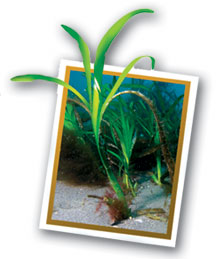|
Resource Protection and Management
Restored Eelgrass Bed Thriving at Anacapa Island
 Found in shallow coastal waters around the world, seagrasses are the driving force behind many thriving marine ecosystems, providing critical food and habitat for countless species of fish and invertebrates. Unfortunately, this important habitat is disappearing at a faster rate than both rainforests and coral reefs alike. But in Channel Islands National Marine Sanctuary, a restored bed of eelgrass — a type of seagrass — is thriving at Frenchy’s Cove on Anacapa Island, six years after the non-profit organization Santa Barbara ChannelKeeper initiated restoration efforts. During sanctuary-approved surveys conducted last spring, divers observed a lush eelgrass bed where vegetation had been previously absent for about 15 years. The eelgrass location has now been restored and is spreading to other nearby sites. Found in shallow coastal waters around the world, seagrasses are the driving force behind many thriving marine ecosystems, providing critical food and habitat for countless species of fish and invertebrates. Unfortunately, this important habitat is disappearing at a faster rate than both rainforests and coral reefs alike. But in Channel Islands National Marine Sanctuary, a restored bed of eelgrass — a type of seagrass — is thriving at Frenchy’s Cove on Anacapa Island, six years after the non-profit organization Santa Barbara ChannelKeeper initiated restoration efforts. During sanctuary-approved surveys conducted last spring, divers observed a lush eelgrass bed where vegetation had been previously absent for about 15 years. The eelgrass location has now been restored and is spreading to other nearby sites.
New Regulations To Protect Gray’s Reef
Gray’s Reef National Marine Sanctuary received increased protection through new regulations that went into effect in February 2007. The regulations prohibit anchoring, discharge and certain types of fishing gear in the sanctuary. Under these regulations, which stem from the revised June 2007 management plan for the sanctuary, NOAA will work with the U.S. Coast Guard and Office of Law Enforcement of the Georgia Department of Natural Resources to ensure compliance. Enforcement reporting is now a regular part of the quarterly sanctuary advisory council meetings and a law enforcement working group of the council has been formed.
Decrease in Vessel Groundings Key to Resource Protection
One of the sanctuary program’s goals is to closely monitor injuries to resources within sanctuary waters and respond appropriately. This is especially important in Florida Keys National Marine Sanctuary, where heavy recreational vessel traffic occurs close to sanctuary resources. In 2007, there were 234 reported vessel groundings in the Florida Keys sanctuary through July 31, representing a decline in the number of groundings in recent years. This success is due to increased enforcement and public education about regulations. The sanctuary program settled several legal cases concerning vessel-related damage in the Florida Keys in 2007, resulting in the recovery of more than $200,000.
Coral Nurseries Established in Florida Keys
Nursery-raised corals may prove to be key building blocks in restoring coral reefs in the Florida Keys. These nurseries are important not only in re-establishing corals where they once existed, but also in preserving the genetic material of the many species of coral found in the Keys. In a first for coral restoration transplant effort, sanctuary scientists and volunteers recently relocated staghorn coral colonies to a reef where the corals had once existed. Through careful monitoring, researchers will identify the corals that survive best under known environmental conditions and use this information in managing coral reefs in the future. Sanctuary biologists also maintain a coral nursery nearshore in Key West that provides corals for research purposes and for restoration projects.
|



